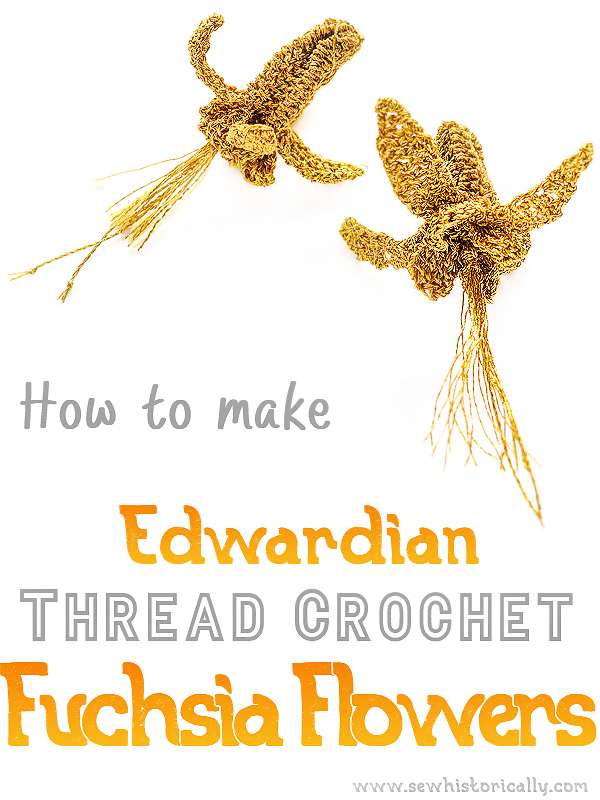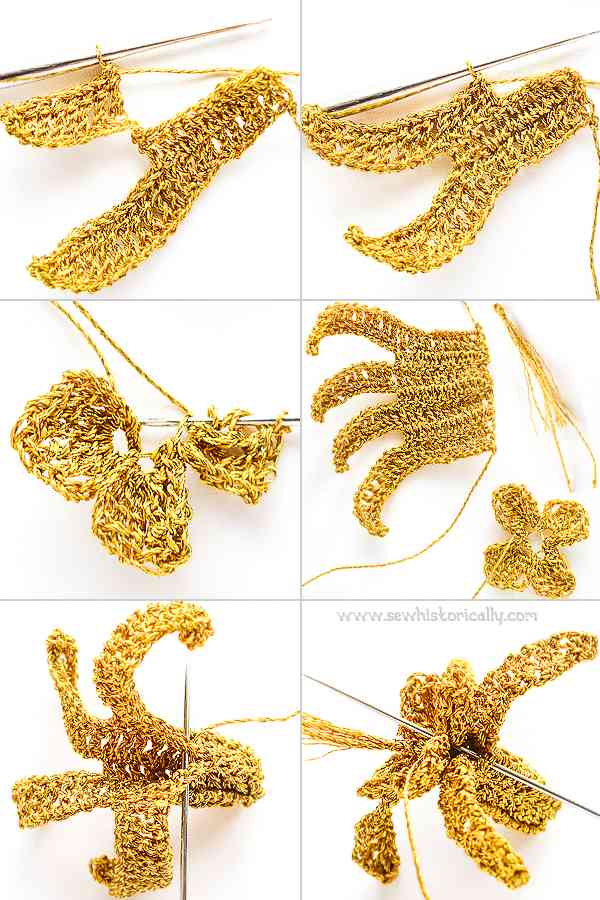Make elegant thread crochet fuchsia flowers by following an original tutorial from the Edwardian era (1910)! 😀
Metallic thread crochet ornaments ‘are distinctly attractive and artistic, and can be accomplished easily by the home worker, at a very moderate cost.’ (Every Woman’s Encyclopaedia, 1910-2)
Edwardian Hoarfrost Ornaments – Metallic Thread Crochet
‘Charming and novel effects can be obtained in “hoar frost” embroidery, a work that will appeal very strongly to all lovers of the dainty and delicate.’ (Every Woman’s Encyclopaedia, 1910-2)
In the Edwardian era, ornaments made of gold, silver or colored metallic crochet thread or metallic ribbon were called ‘hoarfrost’ embroidery. Popular designs were flowers, like fuchsias, campanulas, forget-me-nots, marguerites and pansies, leaves, like ivy leaves, small fruits, like apples, and insects, like butterflies, dragon-flies or beetles.
Related: Edwardian Hoarfrost Fuchsia – Ribbon Flower Tutorial
What Is Edwardian Florestore Work?
‘Florestore Work will be found a most fascinating form of crochet work.’ (Every Woman’s Encyclopaedia, 1910-2)
Florestore work is a different thread crochet work popular in the Edwardian era. It was called ‘florestore work’ when the ornament was crocheted over wire. And because of the wire, the finished florestore ornaments could be bent into any desired shape.
Difference Between Hoarfrost Ornaments & Florestore Work
Hoarfrost ornaments = made of metallic thread or metallic ribbon
Florestore work = thread crochet over wire (with colored of metallic thread)
Hoarfrost and florestore work was often combined in the Edwardian era: thread crochet ornaments made of gold or silver metallic thread crochet over wire were considered the most beautiful.
‘Fuchsia blossoms […] worked in pink and mauve metal thread, with green thread for the leaves, the result would be charming; but carried out in gold, silver, or aluminium, the effect would be even more artistic.’ (Every Woman’s Encyclopaedia, 1910-2)
Uses Of Edwardian Hoarfrost & Florestore Ornaments
In the 1900s, florestore and hoarfrost ornaments were used to decorate hats and dresses and as DIY hair accessories.
‘The gold, silver, and coloured metallic threads so much in vogue at the present time may be put to many fashionable and decorative uses, one of the most charming productions being ornaments for the hair suitable for evening wear.’ (Every Woman’s Encyclopaedia, 1910-2)
‘Flowers in florestore are especially effective on satin-covered shapes, as well as on the fancy straw toques so popular in the spring.’ (Every Woman’s Encyclopaedia, 1910-2)
Related: 15 Christmas Gibson Girl Hairstyles & Holiday Hair Accessories
How To Attach Edwardian Crochet Hair Accessories
‘Fasten the hairpin securely to the stalk by winding the gold thread round it several times. If preferred, the hairpin can be omitted, and the spray pinned in position as required by passing hairpins over the stalk, and then into the hair.’ (Every Woman’s Encyclopaedia, 1910-2)
Related: How To Make Satin Roses – Edwardian Tutorial (1910)
What Metallic Thread For 1900s Hoarfrost Crochet
‘One word as to the metallic threads. If an absolutely untarnishable thread is required, then aluminium should be chosen. It is obtainable on silk and cotton, and in several sizes. It is well for the worker to know that the bright-surfaced metallic or aluminium threads are mounted on a silk or cotton foundation or core. That with a cotton foundation is quite easy in work, but even more pliable is the thread with a silk foundation.’ (Every Woman’s Encyclopaedia, 1910-2)
How To Make Edwardian Thread Crochet Fuchsia Flowers
You’ll Need:
- metallic thread
- thread crochet hook*
- optional: fine wire**
* I used a 0.6mm metric crochet hook for this thread crochet fuchsia. A 0.6mm metric crochet hook is smaller than a size 14 US steel crochet hook.
** The wire is optional if your crochet thread is stiff enough. I didn’t use wire because my thread crochet flower kept its shape without wire.
Outer Bell (Sepals)
‘Work 23 chain; turn, 1 double crochet in second chain from hook, 1 double crochet in next chain, 1 treble in next chain, taking up loop of wire formed by turning about 1 inch of wire back; now, over wire, 1 treble in each next 8 chain, 1 double crochet in each chain to end of chain; 1 chain, turn,
* 1 double crochet into each double crochet of previous row, bend back wire, and work over wire; 12 chain, I double crochet in second chain from hook, 1 double crochet in next chain; 1 treble in next; here bend back wire and take up loop as before; proceed to work over wire, 1 treble in each chain, until double crochet of previous row is reached, then double crochet into double crochet of previous row, and over wire to end, 1 chain, turn, and repeat from * until the four petals which form the outer bell are worked.’ (Every Woman’s Encyclopaedia, 1910-2)
Inner Petals
‘(Wire not being required), make 6 chain, 1 long treble in fifth chain from hook, 6 long treble of 3 times over the needle in same chain, 1 long treble, 5 chain, finish off with 1 double crochet; four of these petals are needed for each blossom.’ (Every Woman’s Encyclopaedia, 1910-2)
Stamens
‘Eight short lengths of […] thread are required; knot cream thread at the end of each, cut off tidily; twist a piece of fine wire round these to keep them in place; let one stamen hang down much longer than its fellows’ (Every Woman’s Encyclopaedia, 1910-2).
Sew The Fuchsia Flower Together
‘Arrange the four petals round the stamens and lightly sew them; sew the outer bell round […] The stems are bound ribbon wire, as, if crocheted, they would be clumsy in appearance’ (Every Woman’s Encyclopaedia, 1910-2).
Related: 10 Ways To Make DIY Fabric Flowers

